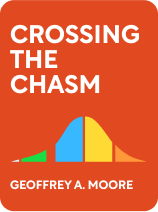

This article is an excerpt from the Shortform book guide to "Crossing the Chasm" by Geoffrey Moore. Shortform has the world's best summaries and analyses of books you should be reading.
Like this article? Sign up for a free trial here .
What are the key characteristics of early technology adopters? What drives early adopters to purchase new, experimental technology?
In his book Crossing the Chasm, Geoffrey Moore calls the early adopters “visionaries.” Most of them are ambitious leaders looking to gain a strategic advantage or make a quantum leap forward by leveraging new technological breakthroughs.
Keep reading to learn about the key characteristics of the early adopter market.
The Key Characteristics of Early Adopters
In his book Crossing the Chasm, Geoffrey Moore explains that early technology adopters assess new technology at a technical level, to determine if it can give them a strategic advantage. Unlike the innovators, they are not interested in new technology for its own sake, but rather in the new advantages it may afford.
- Population size: About one sixth of the population.
- Technical Competence: High. Moore observes that a typical early adopter has the technical insight to identify and implement strategic technologies, as well as the charisma to rally his company around the project.
- Quality Requirements for your product: Moderate. Moore describes early adopters as being comfortable accepting the risk of unproven technology because they envision it providing great benefits. However, he also notes that their expectations often exceed the product’s actual capabilities, making them difficult customers to please in the long run.
- Price Sensitivity: Lowest. Moore asserts that early adopters are usually corporate executives with resources to fund ambitious projects.
- Whole-Product Perspective: According to Moore, early adopters are willing to take responsibility for assembling the whole product because they want to be the first to leverage its capabilities.
- Product Positioning Perspective: According to Moore, early adopters assess your product’s positioning based on how it fits into their vision for the future or could help them realize their ambitions. They communicate broadly to keep an eye out for new technologies with strategic applications, and evaluate them based on technical benchmarks, product reviews, initial sales metrics, and trade press coverage.
Beal and Bohlen’s Perspective on Early Technology Adopters
According to Beal and Bohlen’s original characterization, early adopters tend to be younger and more highly educated than members of the early and late majority. They are well-read and stay well-informed, receiving more technical or agricultural publications than the majority do.
Moore echoes Beal’s assertion that early adopters are well-informed and communicate broadly, especially through publications, but he does not address their average age or level of education. Perhaps these characteristics were more pronounced in the population that Beal and Bohlen studied.
For example, perhaps in a farming community, the average farmer has a two-year degree or equivalent, while early-adopter farmers have graduate-level degrees. Meanwhile, the average office worker of a Silicon Valley manufacturing company has a graduate-level degree, and so highly-educated early adopters don’t stand out as being significantly more educated than the rest of the population.
Beal and Bohlen state that early adopters are also the most likely to hold public office or otherwise be formally involved in the institutions of their respective communities. Moore makes no mention of this, but does say that early adopters usually hold executive positions in their respective companies. Perhaps early adopters in rural farming communities tend to be more involved in municipal politics, while early adopters in advanced manufacturing companies tend to be more involved in corporate politics.
After commenting that innovators tend to have large amounts of risk capital available, Beal and Bohlen offer no comment on the financial status of early adopters. This contrasts with Moore’s description, since Moore identifies early adopters as having the most funding available to spend on cutting-edge technology, while innovators are much more price sensitive.

———End of Preview———
Like what you just read? Read the rest of the world's best book summary and analysis of Geoffrey Moore's "Crossing the Chasm" at Shortform .
Here's what you'll find in our full Crossing the Chasm summary :
- An explanation of the chasm phenomenon that many new high-tech products face
- How to pilot a product across this chasm to mainstream success
- The problems with the Technology Adoption Life Cycle (TALC) model






